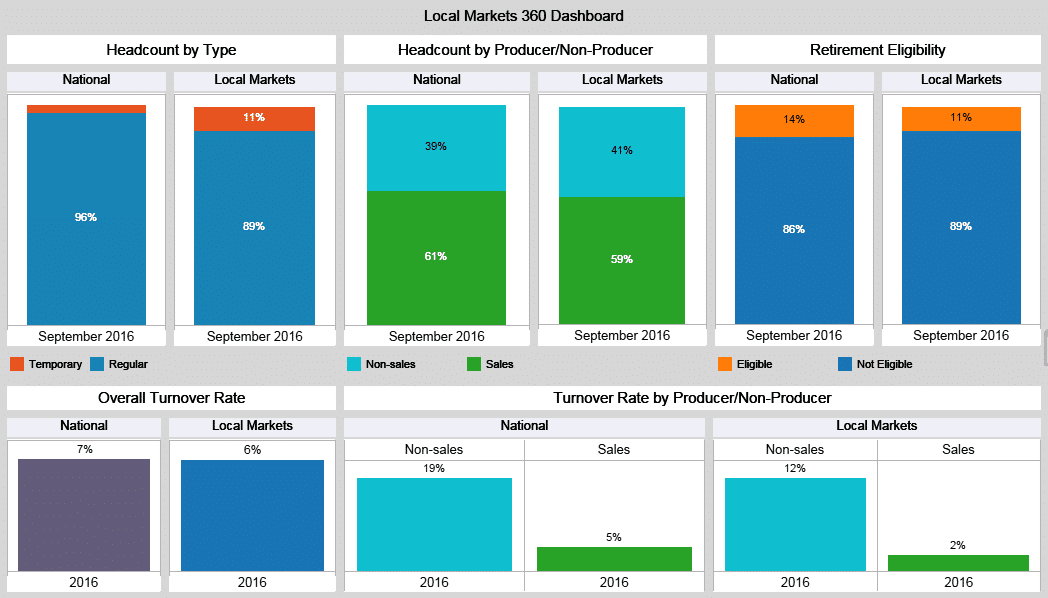CBRE: An HR Analytics Case Study
We chatted with Méline Van Slyke, Director of Human Resources at CBRE Limited, the Canadian arm of the world’s largest commercial real estate services firm. In this HR analytics case study, Méline shares the story of how her team provides analytics to business leaders aligned to key initiatives. Consequently, this data informs decisions for the business.
Méline and her team are true business partners. They listen to the pain points and information needs of the business. And they look to the data for insights to guide decision making.
We asked Méline a set of questions:
1. How has the conversation changed with your Managing Offices as you have evolved your analytics?
We started with a focus in an area top of mind for our business partners – recruitment. In the past we had no way to track and report on our Strategic Recruitment Initiative. But today with our evolved analytics we can dig into the data and reveal important trends and gaps.
This extra visibility into our recruitment data led to a desire to see talent analytics on our existing employee base. We wanted to more easily identify gaps tied to our Strategic Recruitment Initiatives.
Our talent conversations are now supported by real data rather than ‘gut feel’. We also have much better visibility into important comparatives, such as how different offices compare to each other and to the company overall.
2. You currently use dashboards as part of conversations with your leadership team at the Managing Offices. How did you decide which analytics were important to highlight on the dashboards you share?
Knowing the key conversations the business was already having helped me decide which analytics would be most valuable. I then reviewed with a few key stakeholders to get their input and feedback and adjusted based on that.
Given the nature of our industry, we continually work to grow our sales base. As a result, we are in constant recruitment mode. It’s important to have analytics to develop targets and measure progress on the strategic recruitment front. Sales Producers don’t have Pay Grades or Performance Ratings so the business needed to see analytics that layered revenue and commission earnings on top of demographics. That is the key measure of performance in sales, so we worked with HireRoad to find a creative way to accomplish that need.
These were all important in deciding which analytics to highlight on the HR dashboards.
3. You mentioned it was important to provide comparatives of Managing Offices to overall company analytics in your dashboards, what drove the need for side-by-side comparisons?
The business drove the need for these dashboards. When I first started discussing our talent analytics with the market leaders, I received a lot of questions about how their office stacked up against the rest of the country. For example, the leaders wanted to know how they compared in terms of:
- ratio of support staff to sales in their office versus the national average
or
- age group demographics in their sales teams versus the national average
or
- how average revenue for a demographic group in their office compares to national.
These are important business questions for our market leaders, so we wanted to be able to deliver the data and insight they needed to improve their decision making. We worked closely with HireRoad to create customized dashboards to address these important areas. This is an example of one of the dashboards with sample data.

Note: Data shown is sample data.
4. Are there any lessons learned that you could share with others on best practices for communicating with different audiences in the organization?
For the Managing Offices, our key to success has been our focus on partnering with the leaders and being driven to provide analytics and data that they want and need to see to drive their business forward.
It’s about their needs.
To get to this level of partnership, it’s important to have conversations and listen intently for pain points and key decision drivers. Armed with this information, you need to go back to the data and find ways to use analytics to support them in their decision making.
If the analytics aren’t supporting the business in their push forward, the analytics will lose value.
If you would like to reach another HR analytics case study, visit the HireRoad Resources page.